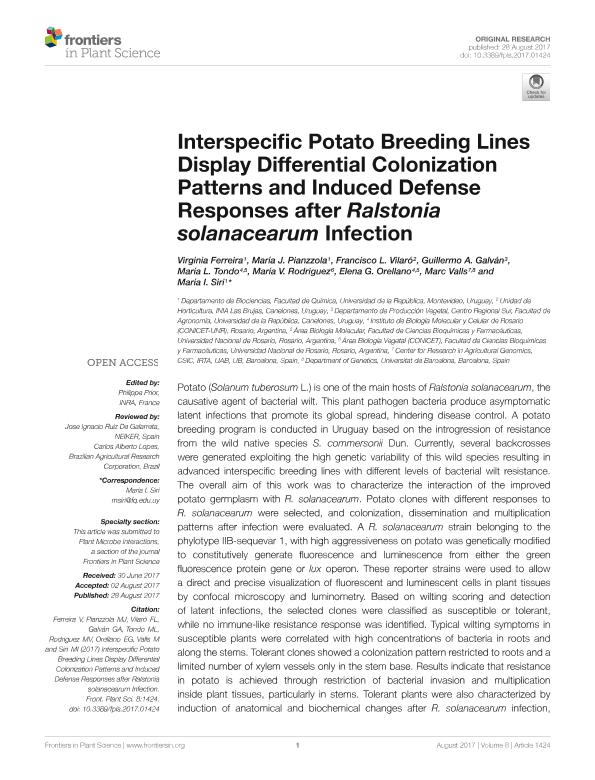Artículo
Interspecific potato breeding lines display differential colonization patterns and induced defense responses after Ralstonia solanacearum infection
Ferreira, Virginia; Pianzzola, María J.; Vilaró, Francisco L.; Galván, Guillermo A.; Tondo, Maria Laura ; Rodriguez, María Victoria
; Rodriguez, María Victoria ; Orellano, Elena Graciela
; Orellano, Elena Graciela ; Valls, Marc; Siri, María I.
; Valls, Marc; Siri, María I.
 ; Rodriguez, María Victoria
; Rodriguez, María Victoria ; Orellano, Elena Graciela
; Orellano, Elena Graciela ; Valls, Marc; Siri, María I.
; Valls, Marc; Siri, María I.
Fecha de publicación:
08/2017
Editorial:
Frontiers Research Foundation
Revista:
Frontiers in Plant Science
ISSN:
1664-462X
Idioma:
Inglés
Tipo de recurso:
Artículo publicado
Clasificación temática:
Resumen
Potato (Solanum tuberosum L.) is one of the main hosts of Ralstonia solanacearum, the causative agent of bacterial wilt. This plant pathogen bacteria produce asymptomatic latent infections that promote its global spread, hindering disease control. A potato breeding program is conducted in Uruguay based on the introgression of resistance from the wild native species S. commersonii Dun. Currently, several backcrosses were generated exploiting the high genetic variability of this wild species resulting in advanced interspecific breeding lines with different levels of bacterial wilt resistance. The overall aim of this work was to characterize the interaction of the improved potato germplasm with R. solanacearum. Potato clones with different responses to R. solanacearum were selected, and colonization, dissemination and multiplication patterns after infection were evaluated. A R. solanacearum strain belonging to the phylotype IIB-sequevar 1, with high aggressiveness on potato was genetically modified to constitutively generate fluorescence and luminescence from either the green fluorescence protein gene or lux operon. These reporter strains were used to allow a direct and precise visualization of fluorescent and luminescent cells in plant tissues by confocal microscopy and luminometry. Based on wilting scoring and detection of latent infections, the selected clones were classified as susceptible or tolerant, while no immune-like resistance response was identified. Typical wilting symptoms in susceptible plants were correlated with high concentrations of bacteria in roots and along the stems. Tolerant clones showed a colonization pattern restricted to roots and a limited number of xylem vessels only in the stem base. Results indicate that resistance in potato is achieved through restriction of bacterial invasion and multiplication inside plant tissues, particularly in stems. Tolerant plants were also characterized by induction of anatomical and biochemical changes after R. solanacearum infection, including hyperplasic activity of conductor tissue, tylose production, callose and lignin deposition, and accumulation of reactive oxygen species. This study highlights the potential of the identified tolerant interspecific potato clones as valuable genetic resources for potato-breeding programs and leads to a better understanding of resistance against R. solanacearum in potato.
Archivos asociados
Licencia
Identificadores
Colecciones
Articulos(CCT - ROSARIO)
Articulos de CTRO.CIENTIFICO TECNOL.CONICET - ROSARIO
Articulos de CTRO.CIENTIFICO TECNOL.CONICET - ROSARIO
Citación
Ferreira, Virginia; Pianzzola, María J.; Vilaró, Francisco L.; Galván, Guillermo A.; Tondo, Maria Laura; et al.; Interspecific potato breeding lines display differential colonization patterns and induced defense responses after Ralstonia solanacearum infection; Frontiers Research Foundation; Frontiers in Plant Science; 8; 8-2017; 1-14
Compartir
Altmétricas



